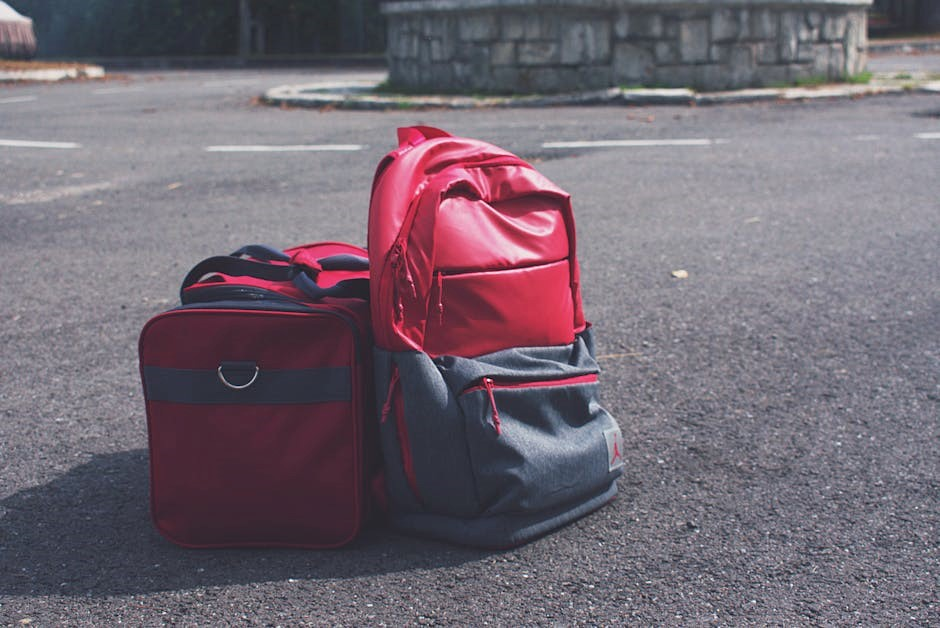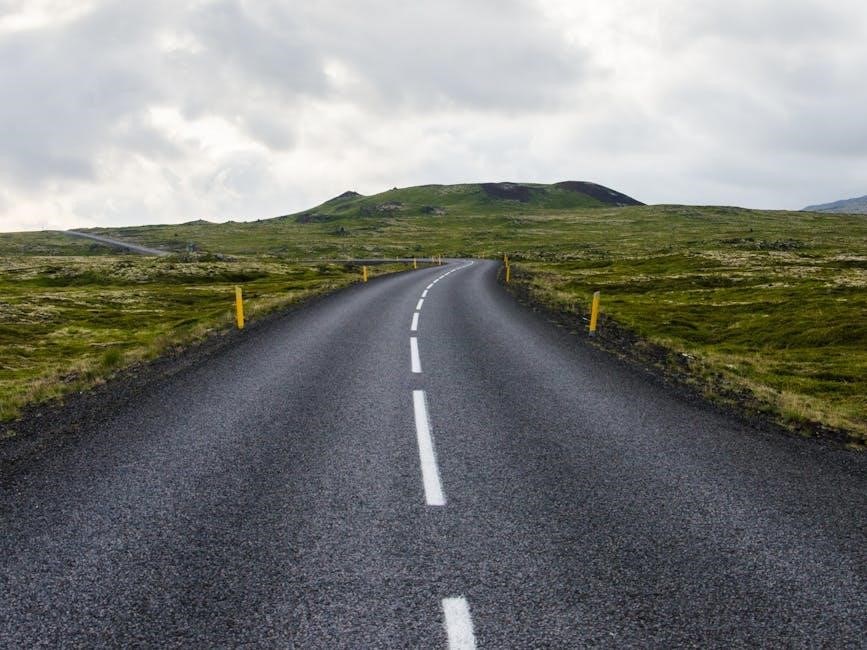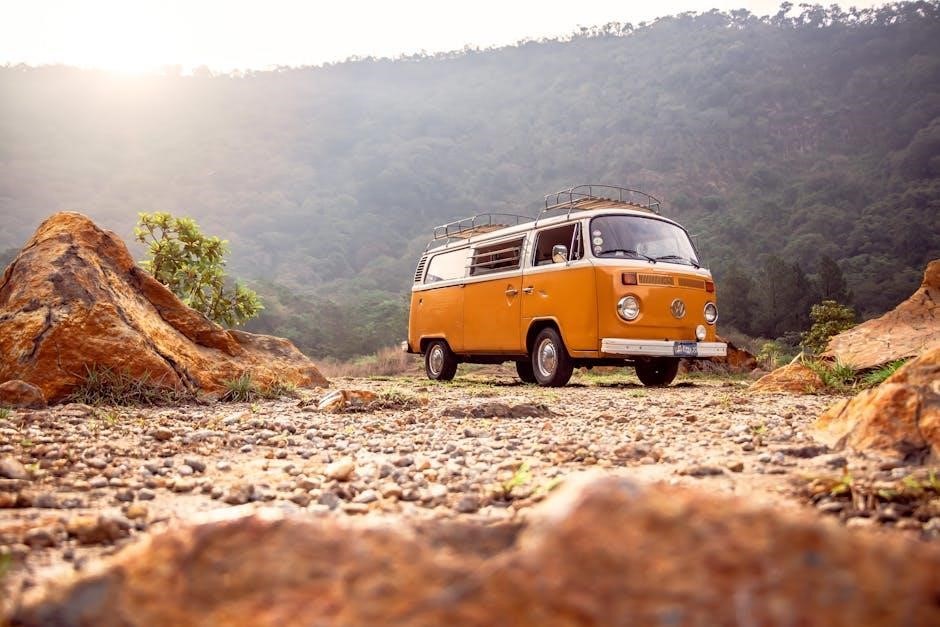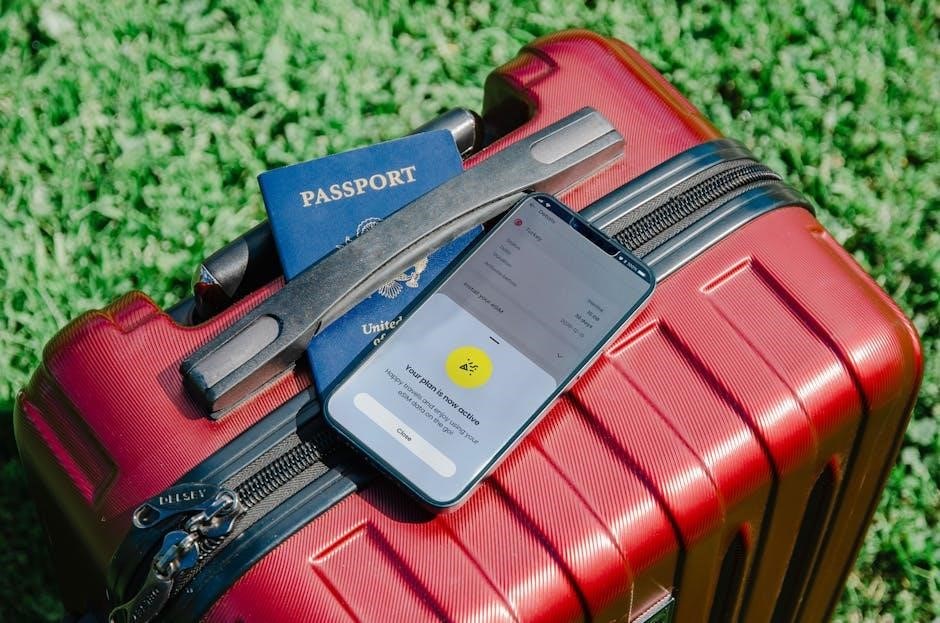
Road Trip Packing List PDF: A Comprehensive Guide
Embarking on a road trip requires meticulous planning, and a comprehensive packing list is essential. A printable PDF checklist ensures you don’t forget vital items, promoting a smooth and stress-free journey.
Planning a road trip involves more than just choosing a destination; it requires careful preparation, especially when it comes to packing. Forgetting essential items can lead to unnecessary stress and detours, impacting the overall enjoyment of your journey. A well-structured road trip packing list PDF serves as an invaluable tool, ensuring that nothing is overlooked. This guide provides a comprehensive checklist covering various aspects of your trip, from vehicle maintenance to personal essentials and entertainment. By utilizing a printable PDF, you can efficiently organize your packing process, making it easier to gather and prepare everything you need. This systematic approach helps to minimize the chances of forgetting crucial items, ultimately contributing to a smoother, safer, and more enjoyable road trip experience. Get ready to hit the road with confidence, knowing you’re well-prepared for whatever adventures await!

Pre-Trip Vehicle Checklist
Before embarking, ensure your vehicle is road-ready. A pre-trip checklist addresses essential maintenance and document verification, preventing breakdowns and ensuring a safe and compliant journey for everyone.
Essential Vehicle Documents
No road trip is complete without ensuring you have all your vehicle documentation in order. This is a critical step to avoid legal complications and ensure a smooth journey. Essential documents include your driver’s license, vehicle registration, and proof of car insurance. Ensure your driver’s license is valid and hasn’t expired. Similarly, double-check the vehicle registration to confirm its current status.
Having your car insurance policy readily available is crucial in case of accidents or emergencies. Consider also carrying a copy of your roadside assistance plan, if you have one. These documents not only provide peace of mind but are also legally required and could save you from potential fines or delays. Keep these documents organized and easily accessible throughout your trip.
Vehicle Maintenance Checks
Before embarking on a road trip, a thorough vehicle inspection is paramount for safety. Begin by checking the tire pressure and condition, ensuring they’re properly inflated and free of wear. Inspect all fluid levels, including oil, coolant, brake fluid, and windshield wiper fluid, topping off as needed.
Test all lights, including headlights, taillights, brake lights, and turn signals, to ensure visibility. Examine the brakes for responsiveness and listen for any unusual noises. Verify the battery’s condition and ensure it’s securely connected. Finally, check the windshield wipers for effective cleaning. Addressing these maintenance points minimizes the risk of breakdowns and guarantees a safer, more reliable trip, making preventative care essential for road trip readiness.

Personal Packing Essentials
Comfort and personal well-being are key to an enjoyable road trip. Essential items include clothing, toiletries, medications, and first-aid supplies. A well-prepared personal pack ensures convenience and addresses individual needs.
Clothing and Accessories
Packing the right clothing and accessories is crucial for comfort and adaptability during your road trip. Consider the climate and activities planned along your route. Pack versatile items that can be layered, such as t-shirts, long-sleeved shirts, and a lightweight jacket. Include comfortable pants, shorts, or skirts suitable for both driving and exploring. Don’t forget essentials like socks, underwear, and pajamas for a restful night’s sleep.
Accessories can enhance your comfort and protect you from the elements. A hat or baseball cap shields your face from the sun, while sunglasses protect your eyes. A scarf or bandana can provide warmth or be used as a dust mask. Comfortable walking shoes or hiking boots are essential for exploring, and slippers can provide comfort in your accommodations. A laundry bag helps keep dirty clothes separate, and shoe bags protect your clean items.
Personal Hygiene Items
Maintaining personal hygiene on a road trip is vital for comfort and well-being. Pack essential toiletries in travel-sized containers to save space and comply with any airline restrictions if part of your trip involves flying. Include shampoo, conditioner, body wash, and soap for showering or washing up at rest stops. Don’t forget a toothbrush, toothpaste, and floss for oral hygiene.
Deodorant is a must-have to stay fresh throughout the journey. Pack facial cleanser and moisturizer to keep your skin clean and hydrated, especially in varying climates. Hand sanitizer is crucial for maintaining hygiene on the go, particularly when access to soap and water is limited. A small mirror can be useful for quick touch-ups. Other helpful items include tissues, wet wipes, and cotton swabs for various cleaning needs. Remember sunscreen.
Medications and First Aid
Prioritize health and safety by packing all necessary medications and a well-stocked first-aid kit. Include any prescription medications in their original containers, along with a copy of your prescription. Pack over-the-counter pain relievers like ibuprofen or acetaminophen for headaches or muscle aches. Antihistamines can help with allergies or insect bites. Motion sickness medication is essential for passengers prone to car sickness.
A comprehensive first-aid kit should contain bandages of various sizes, antiseptic wipes, gauze pads, adhesive tape, and antibiotic ointment. Include pain-relieving spray. Tweezers are useful for removing splinters or ticks. A small pair of scissors can be handy for cutting bandages or other materials. Consider adding any personal medications or items specific to your health needs. Don’t forget sunscreen with at least SPF 40!

Food and Drink Checklist
Prepare for hunger and thirst on the road with a curated food and drink checklist. Pack snacks, non-perishables, and plenty of water to stay energized and hydrated throughout your trip.
Snacks and Non-Perishables
A well-stocked supply of snacks and non-perishable food items is crucial for any successful road trip. Consider packing items that are easy to eat on the go, require minimal preparation, and won’t spoil quickly.
Think about individual servings of trail mix, granola bars, dried fruits, nuts, and seeds. These options provide sustained energy and are relatively healthy. Crackers, pretzels, and popcorn are also good choices for satisfying salty cravings.
For more substantial options, consider peanut butter or cheese crackers, beef jerky, or canned tuna. Fresh fruits like apples, oranges, and bananas are great for the first day or two. Don’t forget resealable bags or containers to keep your snacks organized and fresh.
Having a variety of snacks ensures that everyone in the car finds something they enjoy, preventing “hangry” moments and keeping spirits high throughout the journey.
Drinks and Hydration
Staying hydrated is paramount during a road trip, especially during warmer months. Pack a variety of beverages to quench your thirst and maintain energy levels. Water is the most essential drink, so bring plenty in reusable water bottles or a large water jug to refill along the way.
Consider packing other options like sports drinks to replenish electrolytes, especially if you’re engaging in physical activities during your stops. Juice boxes or pouches are great for kids (and adults!), but be mindful of sugar content.
Iced tea or coffee can provide a caffeine boost for drivers, but consume them in moderation. Avoid sugary sodas, as they can lead to energy crashes. A cooler with ice packs is essential to keep your drinks cold and refreshing throughout the trip.
Remember to stay hydrated even if you don’t feel thirsty, as dehydration can lead to fatigue and decreased alertness.
Food Safety Considerations
Maintaining food safety is crucial when packing snacks and meals for a road trip. Perishable items such as sandwiches, salads, and dairy products require careful handling to prevent spoilage and foodborne illnesses. Utilize a well-insulated cooler with ice packs or frozen gel packs to keep these items at a safe temperature (below 40°F or 4°C).
Avoid leaving food in a hot car for extended periods, as this can rapidly accelerate bacterial growth. Pack food in airtight containers to prevent cross-contamination and leaks. Wash your hands thoroughly with soap and water before handling food, or use hand sanitizer if soap and water are unavailable.
Consider packing single-serving portions to minimize leftovers and potential spoilage. Discard any food that has been left at room temperature for more than two hours, or one hour if the temperature is above 90°F (32°C).
Be mindful of expiration dates and avoid consuming anything that has expired.

Entertainment and Gadgets
Long drives necessitate engaging entertainment. Pack electronic devices like tablets and portable chargers. Don’t forget books, games, and music playlists to keep everyone entertained and prevent boredom.
Electronic Devices
In today’s digital age, electronic devices are indispensable for road trips. Smartphones are essential for navigation, communication, and entertainment. A portable charger or power bank is crucial for keeping devices powered up, especially during long stretches without access to outlets. Tablets can provide entertainment for passengers, allowing them to watch movies, play games, or read e-books. Consider bringing a car charger with multiple ports to accommodate everyone’s devices. Don’t forget headphones or earbuds for personal listening. Pre-downloading entertainment content like movies, music, and podcasts ensures access even in areas with limited or no internet connectivity. A GPS device can be a reliable backup for navigation, especially in remote areas where cell service is unreliable. Remember to bring any necessary cables and adapters for charging and connecting your devices.
Entertainment for Passengers
Long road trips can be tedious, especially for passengers. To combat boredom, pack a variety of entertainment options. Books, magazines, and comics offer a screen-free way to pass the time. Travel games, card games, and board games can provide hours of fun for the whole family. Consider bringing a portable DVD player with movies, or pre-download movies and TV shows onto tablets. Audiobooks and podcasts are excellent for long drives, allowing passengers to relax and listen. Coloring books and art supplies can keep children entertained. Encourage passengers to create playlists of their favorite music. Mad Libs and other word games can spark creativity and laughter. Don’t forget comfort items like travel pillows and blankets to enhance the experience. A well-stocked entertainment bag ensures that everyone has something to enjoy during the journey.

Safety and Emergency Items
Prioritize safety with a well-equipped emergency kit. Include a first-aid kit, jumper cables, a flashlight, warning devices, and necessary tools for minor roadside repairs. Sunscreen is essential for sun protection.
Roadside Emergency Kit
A comprehensive roadside emergency kit is paramount for any road trip, ensuring preparedness for unforeseen circumstances. Essential components include jumper cables for jump-starting a dead battery, a tire pressure gauge to maintain optimal tire inflation, and a spare tire that is properly inflated, accompanied by tools necessary for changing a flat tire.
A flashlight with extra batteries is crucial for visibility during nighttime emergencies, while warning devices such as reflective triangles or flares alert other drivers to your presence. A multi-tool or a basic set of tools can prove invaluable for minor repairs. Don’t forget a first-aid kit equipped with bandages, antiseptic wipes, pain relievers, and any personal medications.
Consider adding duct tape, a tow rope, work gloves, and a blanket for added safety and comfort. Regularly inspect and replenish your emergency kit to ensure all items are in good working condition and readily available.

Navigation and Communication Tools
Effective navigation and communication tools are indispensable for a successful road trip, ensuring you stay on course and connected. A reliable GPS device or smartphone with a navigation app like Google Maps or Waze is crucial for real-time directions and traffic updates. Download offline maps in advance to mitigate connectivity issues in remote areas.
A fully charged phone is essential for communication, but consider a portable charger to prevent battery drain. In case of emergencies, a dedicated emergency communication device like a satellite phone or personal locator beacon (PLB) can be life-saving, especially in areas with limited cell service.
Inform family or friends about your route and estimated arrival times, and check in regularly. A traditional paper map can serve as a backup in case of technological failures, offering a tangible overview of your journey.
Sun Protection
Protecting yourself from the sun’s harmful rays is paramount during a road trip, especially with extended exposure through car windows and during outdoor activities. Pack a high SPF sunscreen (at least SPF 40) and apply it liberally and regularly to all exposed skin, even on cloudy days.
Sunglasses with UV protection are essential to shield your eyes from glare and potential damage. A wide-brimmed hat provides additional shade for your face, neck, and ears. Consider wearing lightweight, long-sleeved clothing for extra protection during hikes or outdoor excursions.
Remember that the sun’s intensity can vary depending on the time of day and location, so adjust your protection accordingly. Don’t forget lip balm with SPF to prevent sunburned lips. Prioritizing sun protection ensures a comfortable and healthy road trip experience.

Documents and Financials
Ensure you have all necessary identification, insurance documents (medical, luggage, civil liability), a valid driver’s license, and international license if needed, plus credit/debit cards and sufficient cash for tolls and emergencies.
Identification and Insurance
A road trip necessitates carrying crucial identification and insurance documents. First and foremost, ensure your driver’s license is valid and hasn’t expired. If traveling internationally, an international driving permit is often required. Vehicle registration and car insurance policy are also paramount, proving ownership and financial protection in case of accidents.
Medical insurance details, including policy number and emergency contact information, should be readily accessible. Travel insurance, covering potential luggage loss or trip cancellations, is also a wise consideration. Keep copies of these documents, both physical and digital, stored separately for easy retrieval. Having these documents readily available can significantly reduce stress and delays if issues arise during your road trip, ensuring a smoother and more secure travel experience.
Cash and Payment Methods
While digital payments are increasingly common, carrying cash remains essential for a road trip. Small towns or roadside establishments might not accept cards. Having a sufficient amount of local currency ensures you can cover tolls, parking fees, and purchases at smaller vendors.
Credit and debit cards are also vital for larger expenses, such as fuel, accommodation, and restaurant meals. Inform your bank of your travel dates to prevent card blocks due to unusual activity. Consider carrying multiple cards as a backup in case one gets lost or compromised. Explore mobile payment options like Apple Pay or Google Pay for convenient and contactless transactions. Always be mindful of security and keep your payment methods safe and secure throughout your trip, ensuring a worry-free financial experience.

Printable Road Trip Checklist PDF
A printable road trip checklist PDF offers a convenient way to organize and ensure nothing is forgotten. Download, customize, and print for stress-free packing and preparation.
Accessing and Downloading the PDF
Accessing your printable road trip checklist PDF is a straightforward process designed for your convenience. Typically, you’ll find a direct download link prominently displayed on a website or within a resource library. Clicking this link will initiate the download, saving the PDF file to your device.
Ensure you have a PDF reader installed (such as Adobe Acrobat Reader) to open and view the document. Once downloaded, you can easily save it to your computer, tablet, or smartphone for quick access.
Many websites offer the PDF as a free resource, while others may require a simple sign-up or subscription. Look for clear instructions and reliable sources to guarantee a safe and hassle-free download experience, allowing you to swiftly prepare for your upcoming road trip. The goal is to make the checklist readily available.

Using the Checklist Effectively
To maximize the utility of your road trip packing list PDF, adopt a systematic approach. Begin by thoroughly reviewing each category, understanding the items listed and their relevance to your specific trip. As you gather your belongings, physically check off each item on the list, ensuring nothing is overlooked.
Consider using a pen or highlighter to mark completed tasks. Keep the checklist readily accessible throughout the packing process, referring to it frequently. For shared trips, involve all travelers in the checklist review to ensure everyone’s needs are met.
Prioritize essential items and pack them strategically for easy access during the journey. Utilize the checklist as a final verification tool before departure, giving you peace of mind. Adapting it to your travel style is important and that means that the checklist is used well.
Customizing the Checklist
While a pre-made road trip packing list PDF provides a solid foundation, tailoring it to your unique needs elevates its effectiveness. Evaluate the standard checklist and identify areas for personalization. Consider the duration of your trip, the destination’s climate, and planned activities.
Add or remove items based on your individual preferences and requirements. For instance, if you’re traveling with children, include toys, games, and comfort items. If you have specific dietary needs, modify the food and drink section accordingly.
Incorporate sections for medications, travel documents, and entertainment. Organize the checklist logically, grouping related items together for easy reference. Don’t hesitate to create entirely new categories if necessary.
Remember to save your customized version for future trips, streamlining the packing process. A customized checklist transforms a generic tool into a personalized travel companion.